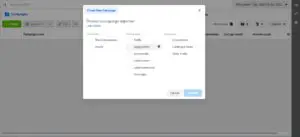Social media is a fundamental aspect of every day life.
Within the last decade, the impact of social media has gone from being an entertaining extra to a fully integrated part of nearly every aspect of daily life for many people.
It has insinuated itself into politics, the workplace, home life and just about every aspect of life you can imagine and continues to evolve at lightning speed. Although this make it difficult to predict which way it will morph next, one thing we can be sure of is that social media isn’t going anywhere so learning how to utilise it to your advantage is key.
Many new and upcoming businesses use platforms such as Facebook & Instagram in order to get their name out there and gym and fitness studios are no different.
Facebook has quickly become one of the most popular to use as an advertising platform as it is far less complicated than most other advertising platforms, such as Google Adwords. Combine that with the fact that your target audience spend a great deal of their day on Facebook and the ability to use precise profile targeting when setting up your ads – it’s a sure fire way to have confidence, knowing your ads are reaching the right people, at the right time.
With the flexibility of choosing a budget that’s right for you, there is no better place to start your online advertisements.
UNDERSTANDING YOUR CAMPAIGN
One of the most crucial elements of creating your Facebook ad campaign is your campaign structure – getting this right will be imperative to its success.
Facebook ads has three levels:
- Campaign
- Ad Set
- Ad
First of all, lets dive in to look at the campaign. The campaign sits right at the top level of your Facebook advertising campaign. This is where you will set a goal or one single objective for the campaign in question. For example, your campaign goal may be to sell 15 memberships each month.
Setting a campaign objective ensures that you have a clear understanding of what you are trying to achieve before you start to create any Facebook ads. So think about what you want your goal behind your Facebook Ad campaign to be. Do you want to:
1. Drive targeted leads to your website?
2. Increase membership sales?
3. Promote a special, limited time offer?
SETTING YOUR OBJECTIVE
When creating your Facebook ad, Facebook will provide you with the following options to select as your objective.
In the example we have used above, of selling 15 memberships each month, the objective you would select is conversions as your campaign objective.
Once you have selected your objective, its time to look at your ad set. This is where you need to identify the audiences you wish to target through specific ad sets. Facebook explains ad sets as:
“A group of ads that share the same daily or lifetime budget, schedule, bid type, bid info and targeting data. Ad sets enable you to group ads according to your criteria.”
Each ad set that you create will target a specific audience, create by you. By creating multiple ad sets, you can ensure the ads you create will relate with the intended audience. For example, your gym or studio might target those those in the 18-30 age group, within a 10 mile radius of your facility.
However, that generic campaign audience can be broken down into much more targeted audiences: female students, aged 18-21; male students, aged 18-12; working mothers with a reduced radius of 5 miles.
The numbers of ad sets you create is dependant on the objectives of your campaign and the type of service your gym offers. Be aware that each of your audiences would be engaged by completely different offers so it is really important of creating targeted audiences for your ad sets.
GET TO KNOW YOUR AUDIENCE
When it comes to any kind of advertising, targeting to a specific audience is essential. No matter what advertising platform you choose to use, if you’re not targeting your offering to the right people then your ad will not achieve the results you desire.
The ideal place to start is to think about your dream customer, or perhaps even multiple dream customers. Write down all the common characteristics that make up this person, or multiple lists of characteristics for all of your customer profiles.
Each of the ad sets you create you should only target one audience at a time, otherwise you risk making your offer too generic in an attempt to try and engage all your audiences which is likely to affect the success of your ad.
When thinking about your audience, consider these key questions:
AGE
What is the age of your dream customer?
Every Facebook user is required to enter their birthday when they sign up, taking the guess work away if you want to target you ad to a specific age group.
GENDER
What is the gender of your dream customer?
Women and men have different ‘Facebook habits’, with women spending slightly more time on Facebook. Women and men will also be attracted to different types of ads.
LOCATION
Where is your gym or studio located?
Your reach will differ depending on where in the country you are based. If you own a gym in a big city, you will only need to target a smaller radius (1-2 miles) than you would in the countryside, due to density of population.
WHAT’S YOUR BUDGET?
Now it’s time to set the budget for your ad set.
When setting up your ads you will be required to set a daily budget and then Facebook will optimise the delivery of your ads in an attempt to meet the stated daily budget. It’s important to note, your daily budget is just an average, and if there is a particular day where there are more opportunities that another, Facebook will spend up to 25% over your budget. Similarly, on days where the opportunities are lower, Facebook may spend up to 25% below your budget.
Facebook tends to spend higher budgets much quicker, so start with a smaller budget and build up slowly – you can trust that Facebook will optimise the smaller amount and provide you with a good return if your ad is attractive to your target audience.
WHAT’S YOUR SCHEDULE?
Now it’s time to turn and consider when you would like your ads to run.
With Facebook ads you have the opportunity to tailor a schedule that is best suited for your audience. Would you like your ads to run continuously and turn them off manually? Or is your preference to select a specific start and end date?
You can also select specific days and time of days to display your ads if you know enough about your target audience to know exactly when you might catch them scrolling social media. The only downside to this is that scheduling is only available for lifetime budgets, as opposed to daily budgets.
TIME TO GET CREATIVE!
The next step to tackle in getting your ad set up is the individual ads for each of your ad sets! Now you need to start thinking about your ad, what is going to capture the attention of your target audience?
It’s a good idea to test multiple ads at the same time to give you the best chance of achieving your desired results. Remember you can always pause ads that aren’t performing how you’d like and keep high performing ads active.
Here are some of our top tips to get you started:

Make sure you use attention grabbing, action-orientated wording. Think about your target audience, what would grab their attention?
People scrolling social media will have a short attention span and are often scrolling through whilst on the go, so you’ll need to get your message across in a couple of lines and encourage users to click for more details.
Include your location in your headline
Although Facebook has great location targeting capabilities, it can still go wrong. Start off by entering a realistic mile radius for your audience and be sure to include your location in the header of your ad to evoke the attention of local users.
Have a call-to-action
The use of a call to action allows you to reflect the offer you are trying to share with your audience. By being upfront and specific from the outset, users will be taking a more defined path of action and you’ll be more likely to achieve your objective.
ADDING A SENSE OF SCARCITY
Adding a sense of scarcity to your offer is a proven and timeless sales technique. The scarcity tactic targets the audiences fear of missing out and evokes and action that they may not do otherwise. This is a really great tactic to apply to your Facebook ads.
Look at the difference in the wording of these two ads:
OPTION 1: Join now and get £20 off with the code NOFEE.
OPTION 2: Join before October 31st and get £20 off with the code NOFEE.
By adding in an expiry date to your offers you are placing a limitation on the offer you are advertising. This will make encourage your audience to take immediate action to ensure they take advantage of the offer before time runs out.
This is a simple sales psychology. By creating a sense of urgency, you are encouraging your target audience to take a particular action in a particular time frame. You have the option to either limit the time that your offer is available, or limit the number available – that’s up to you and the service that you offer, you could even choose both if you wanted!
Giving something a sense of exclusivity makes it instantly more desirable, and the perceived notion that it is of a higher value.
USE RELATABLE VISUALS

Social media is incredibly visual, so when it comes to selecting images to use within your ads you have two options: pay for stock photos; take your own photos within your facility.
Although taking your own photos is desirable as it gives you the opportunity to showcase your facility and make the ad seem more personable, however getting a good quality photo to use is much easier said than done. Lighting is everything as well as ensuring you have a photo which can be optimised for all different devices.

You might also consider using a video instead of an image if you know someone capable of video editing. This gives your target audience that opportunity to understand what your business is about and will bring your ad alive. However, as Facebook videos auto play in the newsfeed, it is key to make them eye catching and compelling. You also need to remember that it is up to the audience as to whether they have the sound on or not, so your video needs to work with sound as well as without.
WHERE TO SEND YOUR LEADS
When your audience is selected, schedule defined, ad written and visual chosen – it’s time to decide where exactly you’re going to send your leads who click on your ad. There are a few questions you should be asking yourself here:
- Where will leads go when they click on my ad?
- What happens when a lead submits a form following my ad?
- What I’ll do with leads who do not complete the desired action?
Although you choose to send your leads to just your Facebook page or homepage of your website, you should ideally create a dedicated landing page. A landing page enables you to create a page which is an extension of your Facebook ad, continuing the offer that you originally grabbed their attention with.
Your landing page should give users the option to take advantage of the offer which they were shown on your Facebook ad, for example if you were advertising a discounted membership, they should be taken straight to a page where they can purchase the membership – with the discount code automatically entered if possible, or repeated on the page and users reminded they will need to enter it. This will make the decision making process much easier and users will more more likely to follow through on the call-to-action.
THE FACEBOOK PIXEL
When setting up your Facebook ad the last step you will come across is adding your Facebook pixel.
The Facebook pixel is code that you place on your website. It collects data that helps you track conversions from Facebook ads, optimise ads, build targeted audiences for future ads and remarket to people who have already taken some kind of action on your website.
The perfect place to add your Facebook pixel is on a customised thank you page. Not only do thank you pages add value to your customers by showing them how much you appreciate their interest or purchase, it also gives you the chance to provide your audience with more information. For example, try and upsell another product or service, educate leads on your gym with a brief explainer video or mention an additional limited time offer.
When more and more conversions happen on your website, Facebook will get better at delivering your ads to people who are more likely to take certain actions, this is known as conversion optimisation.
The top takeaways of the benefits of adding the Facebook pixel are as follows:
- Measure Cross-Device Conversions: Understand how your cross-device ads helps influence conversions.
- Optimise Delivery: Ensure that your ads are shown to the people most likely to take action.
- Create Customer Audiences: Dynamic ads help you automatically show your website visitors the products they’ve viewed on your website.
- Learn About Your Website Traffic: Get rich insights about how people use your website from your Facebook pixel dashboard.
WHAT YOU SHOULD DO NEXT
Now you’ve selected your audience, defined your schedule, written your ad and chosen your visuals – it’s time to consider what are your next steps?
If your ad is performing well, it might be time to consider increasing your budget to try and reach more people. The most effective way of doing this isn’t just to increase the spend on one single ad, so you are better off by duplicating the ad which is performing well and having multiple duplications of the same ad running at the same time, each with a small daily budget which Facebook will optimise to ensure its getting maximum exposure amongst your target audience. You will also have the option to tick ‘leave existing reactions’ each time you copy your ad which we would recommend doing so that all interactions on your ad are also copied across which new people coming across your ad for the first time will find encouraging.
Another option to consider is retargeting your Facebook ad. Unsurprisingly there will be a large number (roughly 75%) of your audience who will see your ad, click through to your landing page and for whatever reason, choose not to take you up on your offer.
There will be numerous reasons why they would have decided not to sign up, so trying to decipher this isn’t important. What’s most important is that due to the inclusion of the Facebook Pixel, you will be able to segment your audience in order to see those people who didn’t follow through with your offer and therefore show the ad to them again.
This time you make subtle changes to your ad in an attempt to try and engage these people a second time round.
To find out more about retargeting your Facebook ads and the process in which to do this, take a look at our ‘Run A Successful Facebook Ad Strategy For Just £1 A Day’ webinar for a more in depth guide.







